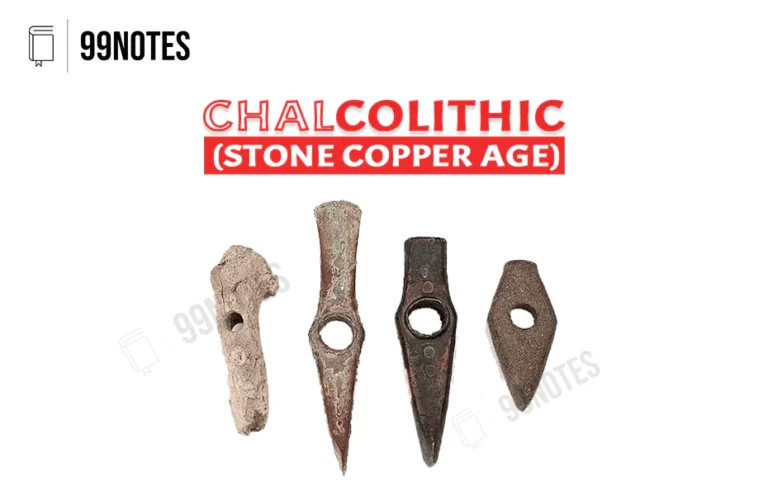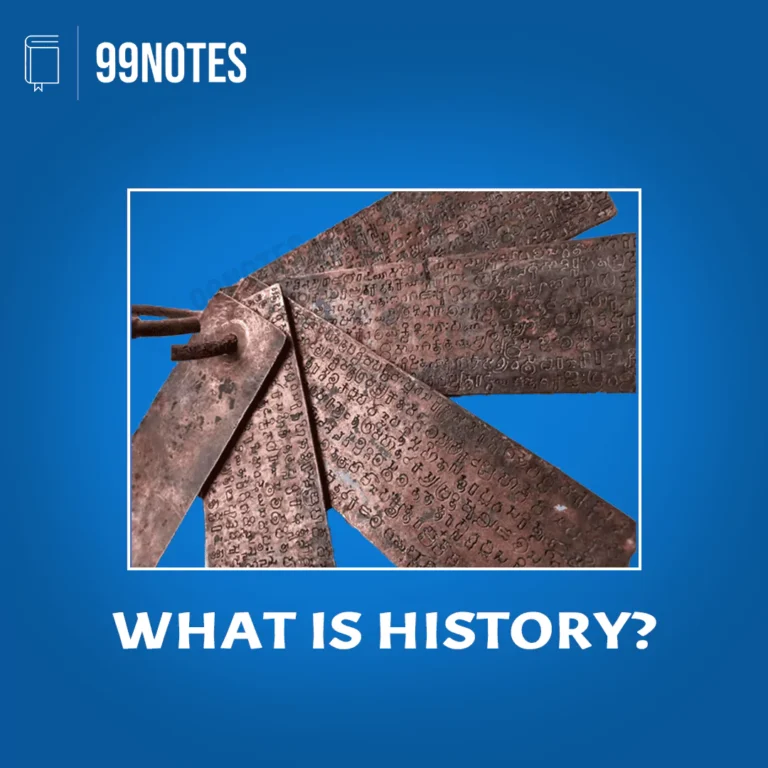Sources of Mauryan Empire and Ashoka’s Edicts – UPSC Notes
Sources of Mauryan Empire and Ashoka’s Edicts
We have several sources that help us to reconstruct the Mauryan empire. These can be classified as either literary sources or Archaeological sources.
Literary Sources
These are the texts that describe the Mauryan Empire. These are either contemporary or non-contemporary.
Contemporary texts – These are books written during the time of the Mauryan Empire.
- Sanskrit Texts: –
- Arthashastra – is a compilation of 15 books, probably composed by Kautilya or Chanakya, traditionally believed to be a minister of Chandragupta. It has a total of 180 chapters. It is a book on political economy and touches following subjects –
- Chapter 1 – on the role of kings.
- Chapter 13 – contains internal affairs.
- Chapter 15 – comments on a state’s economy, politics, and administration.
- Mrichhakatika(Meaning, ‘a clay cart’) – is a 2nd-century BCE Sanskrit drama written by Shudraka. It is a story about the love of a wealthy merchant (Charudatta) with the daughter of a courtesan (Vasantasena).
- Arthashastra – is a compilation of 15 books, probably composed by Kautilya or Chanakya, traditionally believed to be a minister of Chandragupta. It has a total of 180 chapters. It is a book on political economy and touches following subjects –
- Indica – written by Megasthenes, who was a Greek ambassador to the court of Chandragupta. His book survives in fragments.
- It tells that the Mauryan ruler had a standing army of 6 lakh foot soldiers, 30,000 cavalry, and 9,000 elephants.
- It mentions Pandyas of Madurai and Rani Mangamal.
- Further, it contains some wrong information about the Mauryan society, such as the mention of 7 classes of society and the absence of any slaves.
- Buddhist texts-
- Deepvamsa and Mahavamsa are Sri Lankan chronicles written in the 4th and 5th century CE, respectively. They mention the expansion of Buddhism in Sri Lanka. They also mention Sanghmitra and Mahendra, King Ashoka’s daughter and son, and their mission in Lanka. They mention about their relationship with South Indian kingdoms since 6th century BCE.
- Asokavadana & Divyavadana contain a collection of legends built around Ashoka’s personality, his expedition to Taxila to suppress the rebellion, and his conversion to Buddhism. These texts depict a cruel picture of Ashoka before his conversion to Buddhism.
- Ashokavadan also tells us that some damage was done to the Sanchi stupa during the Pushyamitra’s time. Although his son, Agnimitra, rebuilt it.
- Jain literature-
- Kalpasurtra – is a book written by Bhadrabahu, which mentions that Chandragupta deliberately starved to death by conducting Santhara/Sallekhana. Bhadrabahu was the spiritual guide to Chandragupta with whom he moved to Shravanabelagola after abdicating the throne.
Non-Contemporary texts –
- Parshvanatha, or Staviravali Charita – is a Sanskrit maha-kavya written by Hemchandra and focuses on the growth of the doms of Magadha.
- Mudrarakshasa – Written by Vishakhadatta in the 4th century AD, is a Sanskrit drama that describes the overthrow of Nandas by Chandragupta with the help of Kautilya.
- Puranas – Some Puranic literature mentions Mauryan kings. For example, Matsya Purana mentions the names of Dasaratha and Samprati.
Archaeological Sources
Numismatics – Study of coins –
- Mauryans issued the largest number of punched-marked coins. This demonstrates the significant growth in economic activities during the Mauryan times.
Source: RBI 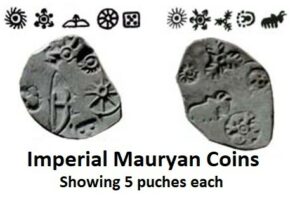
- They used various types of metals to issue coins. Arthshastra names the multiple types of metal coins as follows:
| Name | Metals used |
| Rupyarupa/Karshapana/Pana | Silver coins |
| Tamrarupa /Mashaka | Copper coins |
| Suvarnarupa /Niskha | Gold coins |
| Sisarupa | Lead coins |
- Inscriptions – Indian inscriptions are engraved into stone or other durable materials, such as metals. Some examples are –
- Sohgaura, a copper plate inscription found in Gorakhpur, UP, is written in the Prakrit language in Brahmi script. It tells about the warehouses prepared to store food. It was a measure by Chandragupta to prepare for facing a flood.
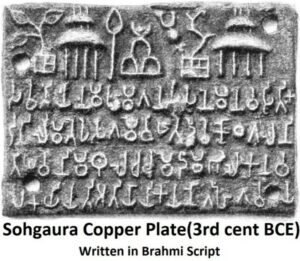
- Sohgaura, a copper plate inscription found in Gorakhpur, UP, is written in the Prakrit language in Brahmi script. It tells about the warehouses prepared to store food. It was a measure by Chandragupta to prepare for facing a flood.
- Mahasthan circular stone Inscription (c 3rd century BCE) in Bogra (Bangladesh) is the earliest epigraphic record in Bengal. It records an order issued by the King to the minister stationed at ‘Pudanagala’ to fill the storehouse or Kosthagara with requisite food as provisions against any emergency caused by flood, fire or damage to crops by parrots.
- On rocks and pillars –Asoka was the first ruler in India who inscribed messages to his subjects and officials on stone surfaces, such as natural rocks and polished pillars.
- Junagarh Rock inscription: The Girnar rock slab contains the Junagarh Rock Edict. It has Ashoka’s Major Rock Edicts 1-14, as discussed later on this page. Further, it contains Saka king Rudradaman’s inscription(Sanskrit), which mentions the history of Sudarshana Lake, apart from his own praise. According to the inscription, it was an artificial lake constructed by a Governor of Chandragupta Maurya named Vaishya Pushyagupta. Later, Ashoka and the Greek king Tusapha built the canals. Later, Skandagupta too engraved on this same rock wherein he called himself the ‘ruler of the earth”.
- Scripts and language used in the inscription:
- As with Ashokan Inscriptions, most inscriptions are written in the Prakrit language and Brahmi script. In Central and Eastern India, the Magadhi Prakrit language is used by Ashoka.
- Occasionally Kharoshti script was used for inscriptions in Greek and Aramaic languages. For example, a bilingual Greek-Aramaic inscription was found at Shar-i-Kuna near Kandahar in southeast Afghanistan and Taxila.
- James Prinsep, an officer in the East India Company, deciphered Brahmi and Kharosthi in 1837.
- A few edicts such as on the Sanchi pillar use a presently undeciphered script. The Scholars describe it as the ‘Shankhalipi’ or the “shell script”.
Ashokan Edicts
Edicts are the official proclamations engraved on pillars, rocks, and cave walls. Ashoka’s royal edicts are inscriptions written in Brahmi script and placed throughout modern-day India, Afghanistan, Nepal, and Pakistan. They are generally found engraved on natural rock surfaces.
Ashoka proposed Dhamma through his edicts. They were also referred to as the Dhammalipi, probably by people who followed Buddhism.
There are 37 inscriptions in total, falling under the following categories:
- Minor Rock edicts – are the earliest edicts inscribed in the 10th – 11th year onwards of the Ashokan rule.
- Major Rock edicts – were inscribed 12th year onwards of the Ashokan rule.
- Minor Pillar edicts – (Year 12 onwards) – Only in North India
- Major Pillar edicts – (Year 26-27 onwards) – Only in North India
Minor Rock Edicts
These were engraved early during the tenth and eleventh years of Ashoka’s reign, i.e. 2.5 years after Ashoka’s conversion to Buddhism, which was the direct and immediate effect of the Kalinga war. So these are the following three royal proclamations, found in 18 places across India.
| Minor Edict 1: |
|
| Minor Edict 2: |
|
| Minor Edict 3: |
|
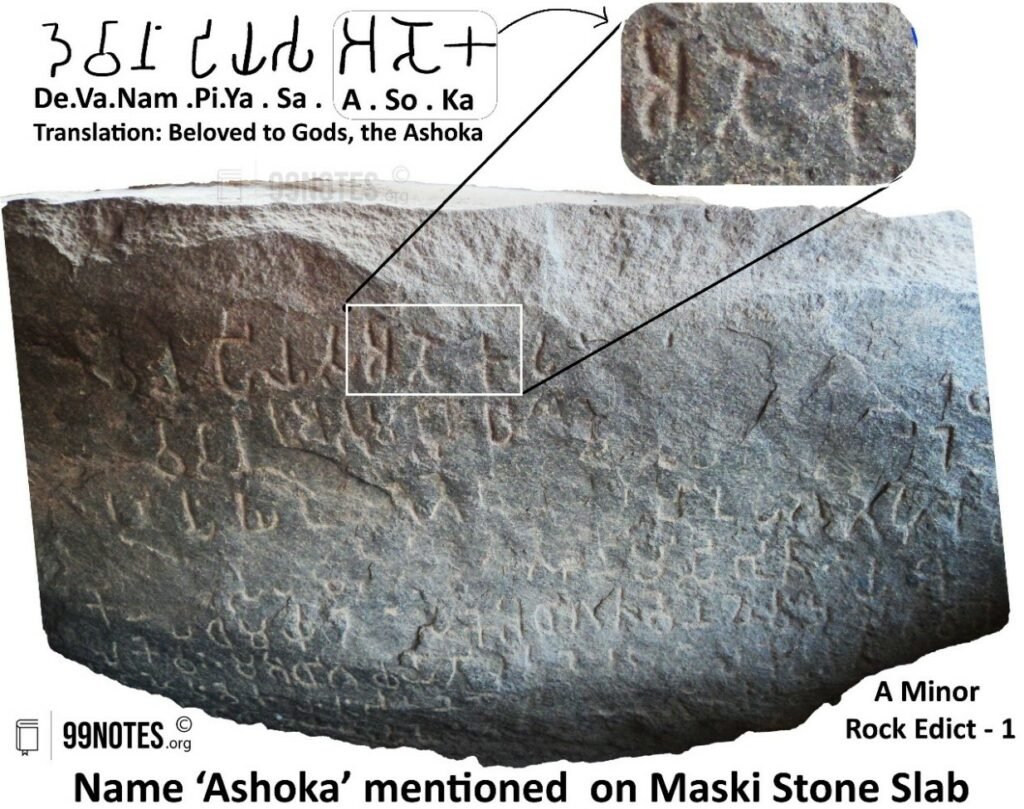
Locations of Minor Rocks edicts: Ashoka’s minor rock edicts are primarily concentrated in the south and central parts of the empire.
| Minor Edict Type | Locations |
| Places with only Minor Edict 1 (North India) | Bahapur (Near Kalkaji Mandir), DelhiGujarra (Jhansi), UP: it is the only inscription apart from Maski Minor Rock Edict 1 to mention king Ashoka by his name.Saru Maru/Panguraria, MP Sasaram, BiharRupnath, Jabalpur, MP (Kaimur Hills)Ahraura, UPRatampurva, Mirzapur, UPBairat, Rajasthan |
| Places with only Minor Edict 1 (South India) | Maski, Karnataka: In 1914, it was the 1st edict discovered with Ashoka’s name. Palkigundu – Gavimath, KarnatakaRajula – Mahendragiri, Andhra |
| Places with Minor Edicts 1 and 2 (None in North India) | Dhauli, OdishaUdegolam, KarnatakaNethur, KarnatakaBrahmagiri, KarnatakaJatinga-Rameshwara, KarnatakaYerragudi, AndhraSiddapura |
| The only place with 3rd Minor Edict | Bhabru, Rajasthan (Near Bairat temple, also called Calcutta-Bairat edict) |
Other Minor Edicts:
- Apart from the above, four other edicts, namely, the bilingual Kandahar Edict, the Laghman Aremic inscription, the Taxila Aremic inscription and the Barabar caves inscriptions, are also included as the minor rock edicts.
- The Kandahar Bilingual Rock Edict(Chehel Zina Edict), found at Shar-i-Kuna near Kandahar, is referred to as the 4th minor rock edict due to its recent discovery. However, it is now evident that it was the oldest edict inscribed by the Ashokan authorities. It contains a general summary of the later inscriptions in Aramaic and Greek.
Major Rock Edicts
After the 12th year of Ashoka’s reign, we find fourteen new edicts in ten locations across India. These are generally placed along the borders of the empire. All Major Rock edicts mention Ashoka as Piyadasin and use the word Devanamapiya as the salutation.
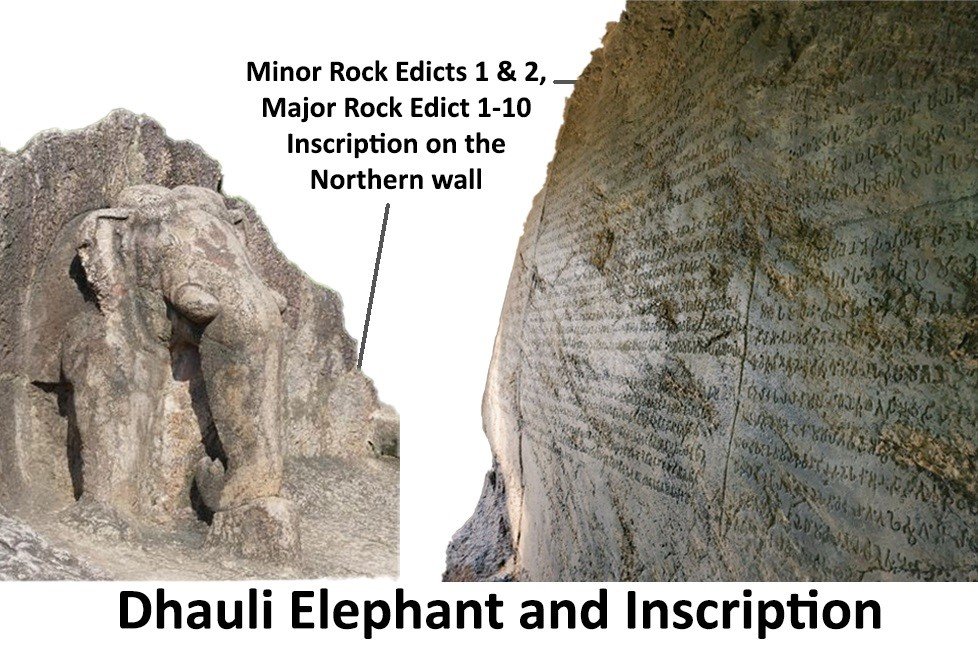
| Edict | Description | Significance |
| Major Rock Edict I |
|
Agriculturalist measure |
| Major Rock Edict II |
|
Agriculturalist measure |
| Major Rock Edict III |
|
To maintain public order |
| Major Rock Edict IV |
|
International relations (soft power) |
| Major Rock Edict V |
|
Governance |
| Major Rock Edict VI |
|
DPSP |
| Major Rock Edict VII |
|
Secularism |
| Major Rock Edict VIII |
|
Populist move |
| Major Rock Edict IX |
|
Moral – Duty |
| Major Rock Edict X |
|
Moral – Duty |
| Major Rock Edict XI |
|
Moral – Duty |
| Major Rock Edict XII |
|
Secularism |
| Major Rock Edict XIII |
|
A picture of Ashoka’s transformation from a brutal and aggressive warrior to a great preacher of peace and love. |
| Major Rock Edict XIV | Purpose of rock edicts. |
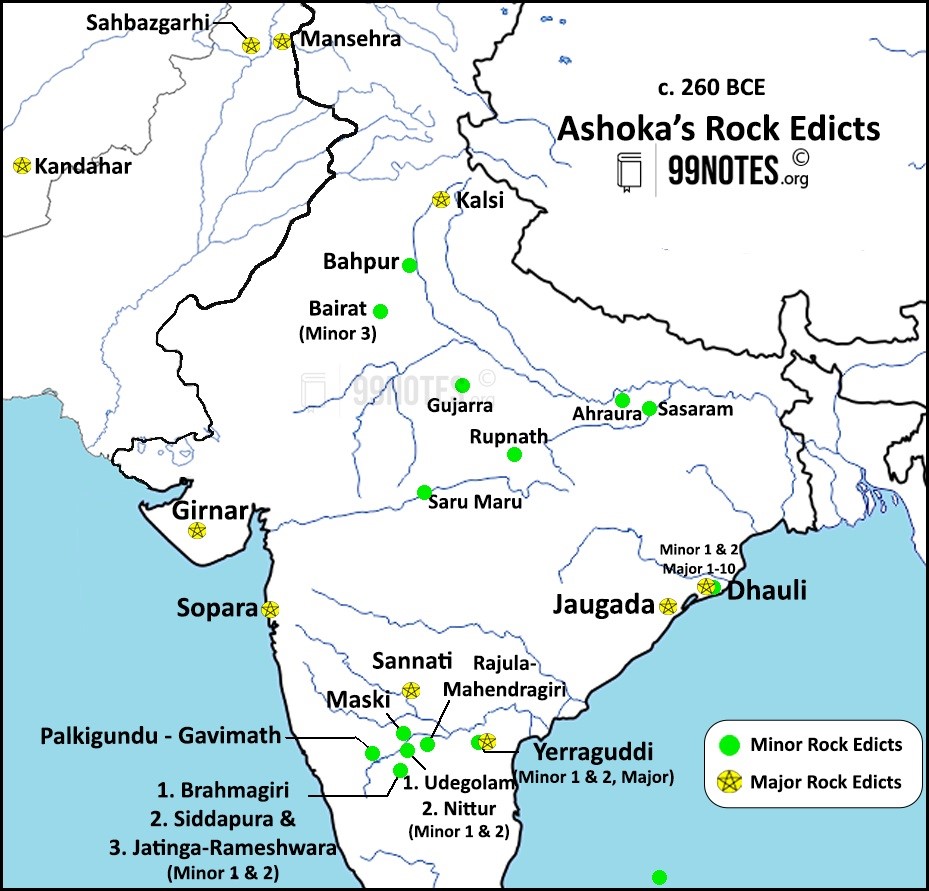
Location of Major Rock Edicts: The 14 major rock edicts are found in the following 10 locations in India:
| Location | Features |
| 1. Kalsi, Uttarkhand |
|
| 2. Supara, Maharashtra 3. Girnar, Gujarat 4. Yaragudi, Andhra 5. Sahbazgarhi Pesawar 6. Mansehra, Khyber |
|
| 7. Dhauli, Bhuvaneshwar, Odisha 8. Jagoda, Ganjam, Odisha |
|
| 9. Sannati Stone Slab – Karnataka |
|
| 10. Kandahar, Afghanistan |
|
Minor Pillar edicts
Minor Pillar Edicts are five separate Edicts of Ashoka inscribed on columns, the Pillars of Ashoka. The art of pillar construction first appeared in Persia in the Achaemenid empire, which were built block by block. However, Ashokan pillars were much more sophisticated and were constructed out of single stone slab. All of them are found in North India.
- Schism Edict – those upon which things unrelated to the Ashokan context are mentioned. This is sometimes because the rulers of other times have inscribed their own message over the original inscription.
| Location | Edict | Capital |
| Sarnath | Sangha would be protected till Mauryan rule lasts | 4 Lions standing back-to-back |
| Sanchi | Sangha would be protected till Mauryan rule lasts | 4 Lions standing back-to-back |
| Allahabad Pillar | It contains- Queen’s edict – by Ashoka’s Queen Tisarakshita,1 to 6 Major Pillar edicts, Samudragupta’s Prayagprashasti, Birbal’s Magh Mela inscription, Jahangir’s inscription. | 1 Lion (Now believed to be lost) |
-
- Commemorative Pillar inscriptions – These are not pronouncements of Ashoka himself but rather later commemorations of his visits to the area.
Major Pillar edicts
| Edict | Ashoka Inscription Details |
| Pillar Edict I |
|
| Pillar Edict II |
|
| Pillar Edict III |
|
| Pillar Edict IV |
|
| Pillar Edict V |
|
| Pillar Edict VI |
|
| Pillar Edict VII |
|
| Location | Contains Edict | Capital |
| 1. Ram Purva, Bihar | Edicts 1 to 6 | Bull Capital |
| 2. Ram Purva, Bihar | Edicts 1 to 6 | Lion Capital |
| 3. Lauriya Araraj, Bihar (‘Laur’ means pillar) | Edicts 1 to 6 | Not present |
| 4. Lauria Navanagarh, Bihar | Edicts 1 to 6 | Lion Capital |
| 5. Allahabad Pillar, UP | Edict 1 to 6 and Queen’s schism edict | Lion Capital |
| 6. Delhi-Meerut (Bought from Meerut to Delhi) | Edicts 1 to 6 | Not present |
| 7. Delhi-Topra (Brought from Topra Kalan to Firoz Shah Kotla, Delhi) | Edicts 1 to 7 | Not present |




